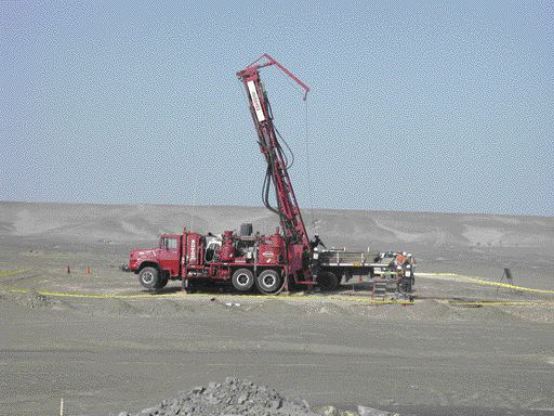A US$6.3-million, 37,000-metre drill program is under way on the Marcona joint venture in southern Peru. The project is owned 70-30 by
Late last year, little-known Chariot overcame a shortage of robust projects, fierce competition, and complex deal-making to acquire Marcona, a relatively recent discovery by Rio Tinto (RTP-N).
The junior beat about 30 other bidders in an auction for the property by agreeing to pay US$33.5 million to the joint owners — subsidiaries of Rio Tinto and Shougang, one of China’s oldest state-run companies.
At the same time, Chariot closed a $27.5-million offering of shares and warrants to finance its 70% share of the acquisition and the first phase of drilling on Marcona, where inferred resources stand at 218.3 million tonnes grading 0.8% copper, or the equivalent of 1.75 million tonnes copper.
Following the offering, Rio Tinto holds 25.6 million shares, or 17.3%, of Chariot, and 12.8 million warrants, representing 18.9% of the junior’s issued and outstanding warrants.
In an unusual twist, the junior also negotiated a side deal with partners Korean Resources Corp., the agency responsible for securing resources for all of Korea’s major industries, and LG-Nikko Copper, a division of LG Cable, to finance 30% of the project. LG has agreed to off-take 90% of Marcona’s cathode production and 70% of its concentrate production.
“This is a model for the future,” says Chariot President Ulrich (Ulli) Rath, during an interview at Chariot’s temporary headquarters in the law offices of McMillan Binch in Toronto. “If you want to build mines, you should have access to the end consumer.”
Rath, former project manager for Antamina and other South American mines, says the deal with the Koreans has differentiated Chariot from its competitors by giving the junior direct access to both the Korean banking system for mine financing and Asia’s huge appetite for metals.
“We don’t need anyone to come along and take us over,” he says. “Little old Chariot has already sold the bulk of our production and we don’t even have a final feasibility study. Who else can say that?”
Still, the upfront numbers are a little daunting for what remains an exploration property. On top of the US$33.5-million purchase price (including US$20.5 million already paid on closing and US$13 million on the second anniversary of closing), Chariot and its partners will pay a US$2.2-million general sales tax plus up to US$10 million should they decide to mine the deposit and the resource meets certain thresholds.
According to a preliminary economic assessment, the capital costs of building an open-pit mine capable of producing 30,000 tonnes of ore per day are estimated to be US$186 million for the initial leaching circuit and US$62 million for a mill to produce copper concentrate.
But Rath believes Marcona’s attributes — the new resource, excellent exploration potential, and access to infrastructure and skilled labour (there is an iron mine next door) — justify the price tag and will keep overall capital costs in check.
Besides, Marcona was the only property in South America to pass the junior’s rigorous fatal-flaw analysis.
“When we started to kiss all these frogs, what we found was that there were a lot of old properties rattling around the system being reactivated,” says Rath. “Most of our competitors have projects that have been around for at least ten years. Many of these projects have major deterrents.”
On the other hand, Marcona is a recent (2002) discovery by Rio Tinto and put up for auction because it did not meet the major’s “strategic objectives” — another way of saying it was too small for them. The project is 25 km from two deep-water ports and skilled mining labour at San Juan de Marcona, 10 km from an existing power line and the Pan American Highway, and 20 km from known sources of water.
Significantly, the project sits in the desert in the heart of an historical mining district, far from any agricultural land or large communities. Chariot has hired a manager of community relations and environmental planning and plans to sit down with selected non-governmental organizations to discuss ways to contribute to local health care and education.
And projected operating costs are well below current copper prices. Cash costs are estimated to be US42 per lb. copper cathode and US76 per lb. copper concentrate for a weighted average life-of-mine production cost of US52 per lb.
Before deciding to sell the property, in late 2003, Rio Tinto drilled more than 100 holes and completed geophysical and geochemical surveys. During the current US$6.3-million program, Chariot will evaluate 20 targets outside the main deposit that have the potential to add up to 368 million tonnes to the resource base.
Marcona is a part of a large iron-oxide-rich hydrothermal system associated with the Marcona iron deposit just a few kilometres from the copper property. The 400-km-long belt that encompasses the two deposits consists of a series of Precambrian gneisses and schists overlain by Paleozoic and Triassic-Jurassic sediments and volcanics. Copper mineralization at Marcona is either structurally controlled as disseminations, veinlets and breccia-filling, or hosted by stratabound iron-oxide mantos.
There are five main prospects on the property, including the Mina Justa prospect, which contains the existing resource. Copper mineralization at Mina Justa occurs in at least three separate zones hosted by volcano-sedimentary rocks in a northeast-trending, southeast-dipping fault system.
The first phase of drilling, scheduled to be complete in July, is expected to expand a portion of the existing resource at Mina Justa, evaluate the exploration targets that have the best potential to increase the current resource base, and identify sites suitable for the future plant and mine infrastructure.
Chariot will begin a feasibility study on Marcona by year-end and intends to reach startup by 2008.
— The author is a Toronto-based geologist and freelance writer specializing in mining and the environment. She may be reached at heffernan@geopen.com


Be the first to comment on "Chariot brings in Koreans to snag Peruvian property"